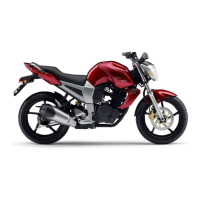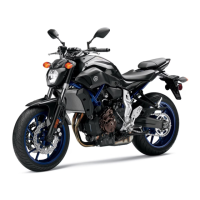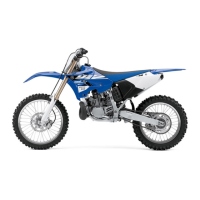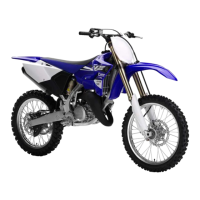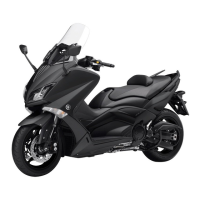Do you have a question about the Yamaha FZ-16 2015 and is the answer not in the manual?
Lists essential tools for maintenance and adjustments, crucial for proper repair.
Provides critical warnings and guidelines before performing maintenance or disassembly.
Detailed technical data for the engine, including dimensions, performance, and materials.
Technical data for the motorcycle's frame, suspension, wheels, brakes, and tires.
Crucial tightening torques for fasteners, essential for safe and correct assembly.
Procedure for draining and replacing engine oil to maintain engine health.
Steps for checking and adjusting valve clearance for optimal engine performance.
Instructions for checking, adjusting, and lubricating the drive chain for optimal performance.
Detailed steps for removing the cylinder head for engine servicing.
Procedures for checking camshaft lobes and dimensions for wear or damage.
Methods for measuring crankshaft deformation, wear, and clearances.
Procedures for removing, disassembling, and inspecting the front wheel.
Steps for disassembling, checking, and measuring rear brake components.
How to check for play, damage, and proper assembly of the steering column.
Procedures for checking ignition system components and circuit diagrams.
Diagnosing and fixing issues with headlights, taillights, and indicators.
Steps for checking battery voltage, electrolyte level, and proper charging procedures.
Diagnosing and resolving issues related to the engine not starting or running poorly.
Troubleshooting common engine performance issues and warning light indications.
Lists essential tools for maintenance and adjustments, crucial for proper repair.
Provides critical warnings and guidelines before performing maintenance or disassembly.
Detailed technical data for the engine, including dimensions, performance, and materials.
Technical data for the motorcycle's frame, suspension, wheels, brakes, and tires.
Crucial tightening torques for fasteners, essential for safe and correct assembly.
Procedure for draining and replacing engine oil to maintain engine health.
Steps for checking and adjusting valve clearance for optimal engine performance.
Instructions for checking, adjusting, and lubricating the drive chain for optimal performance.
Detailed steps for removing the cylinder head for engine servicing.
Procedures for checking camshaft lobes and dimensions for wear or damage.
Methods for measuring crankshaft deformation, wear, and clearances.
Procedures for removing, disassembling, and inspecting the front wheel.
Steps for disassembling, checking, and measuring rear brake components.
How to check for play, damage, and proper assembly of the steering column.
Procedures for checking ignition system components and circuit diagrams.
Diagnosing and fixing issues with headlights, taillights, and indicators.
Steps for checking battery voltage, electrolyte level, and proper charging procedures.
Diagnosing and resolving issues related to the engine not starting or running poorly.
Troubleshooting common engine performance issues and warning light indications.
| Engine Type | Air-cooled, 4-stroke, SOHC, 2-valve |
|---|---|
| Displacement | 153 cc |
| Bore x Stroke | 58.0 mm x 57.9 mm |
| Compression Ratio | 9.5:1 |
| Maximum Power | 14 PS @ 7500 rpm |
| Fuel System | Carburetor |
| Transmission Type | 5-speed constant mesh |
| Front Suspension | Telescopic fork |
| Rear Suspension | Monocross |
| Front Brake | Disc |
| Rear Brake | Drum |
| Front Tire | 100/80-17 |
| Rear Tire | 140/60-R17 |
| Fuel Tank Capacity | 12 liters |
| Kerb Weight | 137 kg |
| Overall Length | 1, 975 mm |
| Overall Width | 770 mm |
| Overall Height | 1, 045 mm |
| Seat Height | 790 mm |
| Wheelbase | 1, 335 mm |
| Ground Clearance | 160 mm |
| Starting System | Electric start |
| Lubrication System | Wet sump |
| Clutch Type | Wet, multiple-disc |
| Frame Type | Diamond |
| Maximum Torque | 14 Nm @ 6000 rpm |
| Ignition System | CDI |
